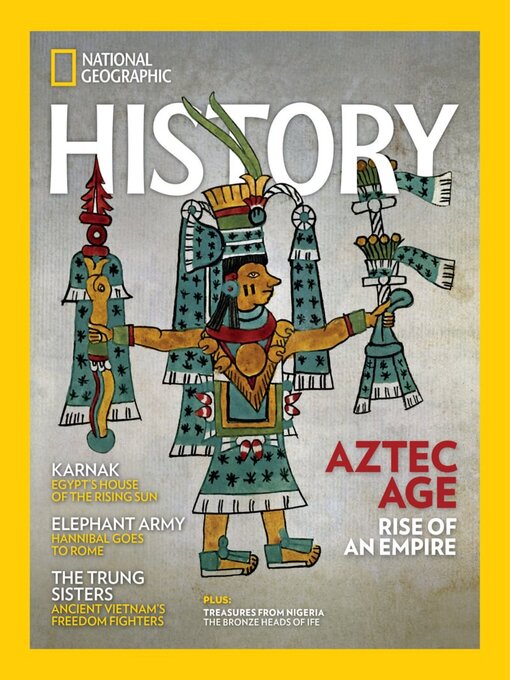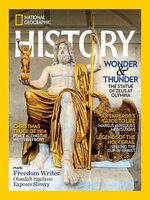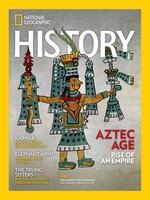See how National Geographic History magazine inflames and quenches the curiosity of history buffs and informs and entertains anyone who appreciates that the truth indeed is stranger than fiction with a digital subscription today. And that history is not just about our forebears. It’s about us. It’s about you.
FROM THE EDITOR
National Geographic History
Stone Age Seashell Makes Music From the Past • Stored in a museum for decades, a seashell was reexamined, providing new insight on the role of music in Upper Paleolithic societies.
STONE AGE SYMPHONICS
Disease Detective
Robert Koch, The Bacteria Hunter • One of the founding fathers of microbiology, Koch used scientific rigor and hands-on experiments to identify the bacterial causes of several illnesses that ravaged the 19th century.
PROFESSIONAL RIVALS
THE RIDDLE OF TYPHOID MARY
BIDING ITS TIME
VIENNA OR FRANKFURT?
The Hot Dog: American Icon • It’s hard to imagine the United States without hot dogs, perfect for baseball games and cookouts, but before the industrial revolution, they were just a taste of the old country for German immigrants in the 19th century.
The Most American Food
SAUSAGE FACTORIES
Eleanor of Toledo: Power of a Portrait • Bronzino’s 16th-century portrait won the hearts and minds of Florentines who were suspicious of a young duchess born in Spain and married to a Medici.
1844 Morse Code: Communication Goes Electric • Scientific advances gave Samuel Morse and his collaborators the opportunity to invent a faster form of long-distance communication: the telegraph and its electronic alphabet.
ELECTRONIC ALPHABET
ADORING AMUN SACRED RITUALS AT KARNAK • For millennia, the temple complex at Karnak stood at the spiritual center of Egypt, where priests performed sacred rituals to honor Amun, the powerful god on whom the pharaohs’ fortunes depended.
MAKING THEIR MARK
PHARAONIC RENOVATIONS
AMUN ACROSS THE CENTURIES
RITES AND RESPONSIBILITIES
HANNIBAL’S ALPINE ASSAULT WAR ELEPHANTS OF CARTHAGE • Carthaginian leader Hannibal marched war elephants over the Alps, a feat that earned him eternal fame, but using elephants in military campaigns has a long history that goes back to the time of Alexander the Great.
BEASTS OF WAR
Charging Against Rome
ELEPHANTINE DEBATES
THE LONG MARCH
Elephant Endgame at Zama
A TOWERING MYSTERY
THE TRUNG SISTERS • Descendants of dragons and riders of elephants, the sisters Trung Trac and Trung Nhi became national heroes by uniting ancient Vietnam to expel the powerful Han dynasty.
ENDANGERED ELEPHANTS
KINGDOMS OF THE PAST
FIGHTING TRADITIONS
RISE AND FALL OF THE AZTEC • Before their defeat in 1521, the Mexica people, known today as the Aztec, had evolved from a nomadic people to Mesoamerica’s dominant power in less than a century.
LANDS OF THE AZTEC • The Triple Alliance (popularly known as the Aztec) conquered lands so as to be able to control trade routes and raw materials. Scholars believe religion also played a large role in expansion since the Aztec required human sacrifices to maintain the cosmic order.
CONQUEST AND SACRIFICE
CODEX FOR A KING
ROYAL TRIBUTES • THE CODEX MENDOZA contains a section that details the tributes received by Moctezuma II, who ruled Tenochtitlan between 1502 and 1520. From the 400 cities under his control, he received a plethora of gifts. In the codex, pictograms correspond to city names and the images next to them show their tributes to Moctezuma. Above each object is a translation in Spanish.
THE FAIRYTALE KING • As modern Germany began to rise, King Ludwig II of Bavaria withdrew from politics. He buried himself in...

 November/December 2024
November/December 2024
 September/October 2024
September/October 2024
 July/August 2024
July/August 2024
 May/June 2024
May/June 2024
 March/April 2024
March/April 2024
 January/February 2024
January/February 2024
 November/December 2023
November/December 2023
 September/October 2023
September/October 2023
 July/August 2023
July/August 2023
 May/June 2023
May/June 2023
 March/April 2023
March/April 2023
 January/February 2023
January/February 2023
 November/December 2022
November/December 2022
 September/October 2022
September/October 2022
 July/August 2022
July/August 2022
 May/June 2022
May/June 2022
 March/April 2022
March/April 2022
 January/February 2022
January/February 2022
 November/December 2021
November/December 2021
 September/October 2021
September/October 2021
 July/August 2021
July/August 2021
 May/June 2021
May/June 2021
 March/April 2021
March/April 2021
 January/February 2021
January/February 2021
